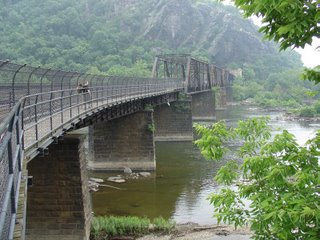
June 25, 2006
Wow, is it June 25 already? Just six more months to do your Christmas shopping, folks.

Yesterday was my friend Rashmi’s 29th birthday. (I told her it’s all over for her now.) Man, to be 29 again. . . .
Anyway, for her special day she wanted to go to Harpers Ferry, West Virginia—a town rich with history. Harpers Ferry is nestled in a beautiful valley where the Maryland, Virginia, and West Virginia borders meet. The small town is surrounded on two sides by rivers – the Potomac and the Shenandoah. Driving there on Route 340, one minute we were in Maryland, the next minute we passed a “Welcome to Virginia sign,” and immediately thereafter we found ourselves in yet another state.

This might have been my first time in WV, I’m not sure. But I must say, my visit there shattered my stereotypical illusion that this state is not worth seeing - you've heard all the jokes about WV being nothing but a hillbilly state with lots of inbreeding. Me, I always thought of it as that place on the map to the left of beautiful Virginia. But, from what I saw and learned yesterday, WV is a beautiful place that played an important role in this country’s formation and the establishment of “free states.”
This little town was once a booming metropolis, famous for its role in the Civil War as one of two armories in the nation. Thomas Jefferson wanted to preserve its natural beauty, but President George Washington had an opposite plan when he established the U.S. Armory and Arsenal there in 1794.
 The armory employed up to 400 men who worked 10 hours a day for 20 cents per hour. Eventually the town was heavily polluted by coal smoke from arms production. It was plagued by disease and an astounding number of floods.
The armory employed up to 400 men who worked 10 hours a day for 20 cents per hour. Eventually the town was heavily polluted by coal smoke from arms production. It was plagued by disease and an astounding number of floods.Harpers Ferry is also famous as the location of John Brown’s raid in 1859, when the abolitionist and several of his cronies holed up in the tiny fire engine house in an effort to steal weapons from the nearby arsenal at Harpers Ferry.
 Much blood was shed and, although wounded in the neck by the slash of a Marine’s sword, John Brown survived the ordeal—only to be hanged for treason and other crimes less than two months later.
Much blood was shed and, although wounded in the neck by the slash of a Marine’s sword, John Brown survived the ordeal—only to be hanged for treason and other crimes less than two months later. The event is considered to be one of the major precipitators of the Civil War and Lincoln’s emancipation proclamation. And although many men were killed or murdered as a result of John Brown’s actions, his efforts contributed greatly to the freeing of the slaves.
The event is considered to be one of the major precipitators of the Civil War and Lincoln’s emancipation proclamation. And although many men were killed or murdered as a result of John Brown’s actions, his efforts contributed greatly to the freeing of the slaves.So, I learned a lot yesterday. Rashmi is quite the history buff. Later she wants to visit Antietam (just 20 miles north of Harpers Ferry), the battlefield that saw the bloodiest of Civil War battles, as described on the Web:
“To view the magnitude of the losses, consider that Antietam resulted in nine times as many Americans killed or wounded (23,000 soldiers) as took place on June 6, 1944--D-day, the so-called "longest day" of World War II. Also consider that more soldiers were killed and wounded at the Battle of Antietam than the deaths of all Americans in the Revolutionary War, War of 1812, Mexican War, and Spanish-American War combined.”In Harpers Ferry, we toured the town. Most homes were built in the 1800’s, and interns walk around in period dress performing reenactments—like the musket demonstration given by a bright college Senior working on his History major and Civil War minor). Unfortunately, because it was such a muggy day, the actors were unable to get the musket to fire, even after three or four attempts. No spark, no fire.
Can you imagine being a soldier in a ground war where you couldn’t be sure your rifle would fire? And then, if it did fire and you managed to hit your mark, it would still take you another 60 seconds to reload and fire the next round? Man, you’d feel like a sitting duck most of the time. I’d be petrified.
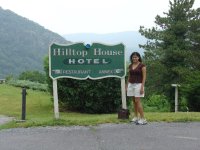 It was interesting learning how the guns were made and used, how a disgruntled ex-employee of the armory shot and killed the Superintendent in his office when he was denied return to employment, and other historical facts.
It was interesting learning how the guns were made and used, how a disgruntled ex-employee of the armory shot and killed the Superintendent in his office when he was denied return to employment, and other historical facts. 
We ate a birthday lunch at the Hilltop House Hotel, where they serve a buffet complete with dried coconut cake (and a hostess who acts like you're impositioning her by dragging her away from her dishwashing duties so you can be seated: "Ugh, can I wash my hands first?")
The restaurant view of the Potomac, with its kayakers, tubers, and rafters, was just gorgeous.

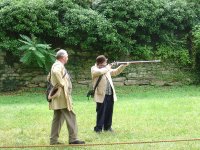



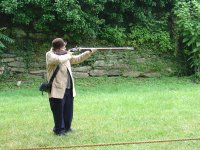
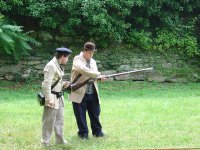
No comments:
Post a Comment